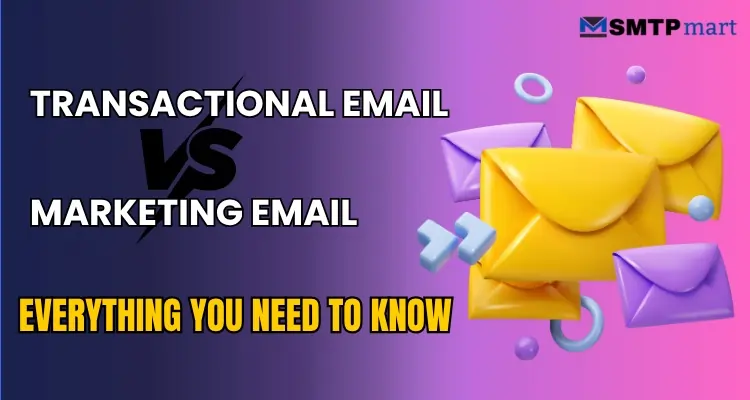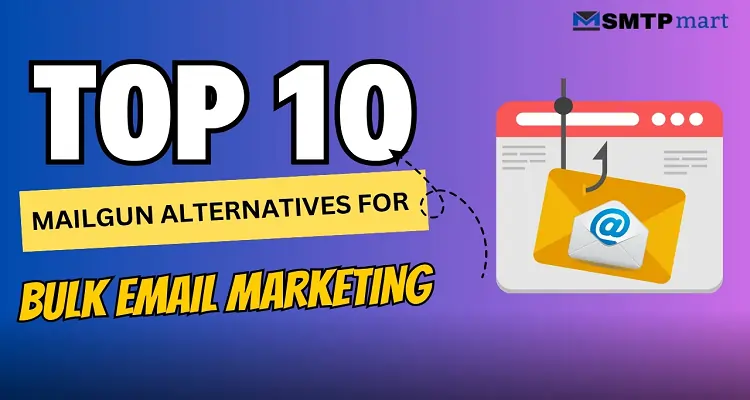Transactional Email vs Marketing Email might sound a bit technical, but it’s actually a very important difference you need to know if you send emails to customers. These two types of emails do very different jobs. One helps your users with things like order updates or password resets. The other is used to share news, offers, or promote your business. If you don’t use them the right way, it can hurt your email results or even break email rules.

In this guide, I’ll explain both in simple words what Transactional Email vs Marketing Email are, how they work, when to use them, and which tools can help. Whether you’re new to email or looking to improve, this will make everything easy to understand.
What is a Transactional Email?
Transactional emails are messages we send after someone does something, like placing an order or signing up on a website. These emails are not used to sell anything. They are not ads or promotions. Instead, they are important and personal messages sent to just one person at a time.
They give helpful information based on what the user just did. For example, if someone buys a product, they get an email confirming their order. If they forget their password, they get an email to reset it.
These emails help users feel informed and supported. They show that the system is working properly and that the business cares about keeping them updated.
Imagine a customer makes a payment and doesn’t get a receipt. Or they sign up for a webinar and never get the joining link. That would be a frustrating experience. That’s where transactional emails play an essential role in keeping the customer informed, engaged, and confident in your brand.
What is a Marketing Email?
Marketing emails are messages we send to tell people about our products, services, offers, or news. These emails are used to promote something. Unlike transactional emails, marketing emails are usually sent to many people at the same time, like your customer list or email contacts. They are not sent because someone did something. Instead, we send them to share updates or invite people to check out what we are offering.
Here are some easy examples of marketing emails:
- Sales offers like “Buy 1, Get 1 Free”
- Newsletters with tips or updates
- Announcements about new products or features
- Emails about special holiday sales
- Messages to bring back people who have not visited in a while
Marketing emails help you stay connected with people, remind them about your brand, and encourage them to buy from you. Because these emails are used to promote something, there are some rules you must follow. People must give you permission to send them these emails, and you also need to give them a way to stop getting your emails if they want to.
Why Marketing vs Transactional Email Matters?
So why should we care about this distinction? Because mixing up transactional and marketing emails can hurt your deliverability, violate laws, and damage user trust.

Let me explain:
- If you include promotional content in a transactional email, it might get flagged by spam filters or even breach regulations like GDPR or CAN-SPAM.
- If your marketing email is too vague or feels like a system update, users might ignore it or forget they subscribed at all.
Understanding transactional vs marketing email helps us send better, clearer, and more legally compliant communication.
Key Differences between Transactional Email vs Marketing Email
Let’s take a closer look at how these two types of emails compare.
| Feature | Transactional Email | Marketing Email |
|---|---|---|
| Purpose | To deliver essential information after a user action | To promote a product, service, or message |
| Triggered By | A user activity (purchase, signup, password reset) | A marketing schedule or campaign |
| Personalization | Highly personalized and context-driven | May be personalized, but typically more generic |
| Opt-In Required? | Not necessarily | Always required |
| Unsubscribe Option? | Not required, but can be included | Legally required |
| Volume | One-to-one | One-to-many (bulk) |
| Spam Filter Risk | Low (if content is purely transactional) | Higher (due to promotional content) |
| Examples | Order confirmation, account updates, and alerts | Sales emails, newsletters, promotional offers |
Knowing this transactional email vs marketing email distinction helps us choose the right strategy, the right tools, and the right message.
Can You Add Marketing Content in a Transactional Email?
Technically, transactional emails should not include promotional content. Doing so can:
- Lead to legal issues (violating anti-spam laws)
- Lower your email deliverability
- Frustrate or confuse customers
That said, there is some flexibility.
For example, in an order confirmation email, we might include:
- “You may also like these products…”
- A referral link
- A discount code for the next purchase
As long as the primary purpose of the email remains transactional, small promotional elements are usually okay. Just don’t turn it into a full-on marketing blast.
Use Cases: When to Send Each Type
Here’s how I like to use both marketing and transactional emails in real-life scenarios:
Example 1: E-commerce Store
- Transactional Email: Order confirmation, shipping updates, return processing
- Marketing Email: New product launch, abandoned cart recovery, holiday sale
Example 2: SaaS Business
- Transactional Email: Account signup confirmation, invoice receipt, trial expiration notice
- Marketing Email: Product updates, feature launches, customer stories
Each type of email plays a role, and when we use both correctly, we create a better customer journey.
Best Practices for Each Email Type
Let’s look at some practical tips to keep your emails clean, clear, and effective.

Transactional Email Best Practices:
- Keep the subject line clear and informative.
- Include all necessary information (order ID, support link, etc.).
- Use a clean layout and avoid promotional banners.
- Send immediately after the user action.
- Ensure deliverability with a reliable SMTP server.
Marketing Email Best Practices:
- Write compelling subject lines and CTAs.
- Segment your audience for better targeting.
- A/B test your emails for better open and click rates.
- Always include an unsubscribe link.
- Respect privacy laws and only email users who’ve opted in.
Popular Tools for Sending Transactional and Marketing Emails
Not all email platforms are created equal. Some specialize in transactional, others in marketing, and some handle both.

Tools for Transactional Emails:
- SMTPmart – Affordable and reliable SMTP service for transactional emails.
- Mailgun – Great for developers and app-triggered messages.
- Amazon SES – Low-cost, scalable email service.
- iDealSMTP– Excellent deliverability and speed for transactional emails.
Tools for Marketing Emails:
- DigitalAka– Simple and user-friendly for email campaigns.
- Brevo (formerly Sendinblue) – Good for both marketing and transactional.
- ConvertKit – Best for creators and bloggers.
- Klaviyo – Ideal for eCommerce brands.
Some of these tools offer free transactional email marketing tiers — perfect for small businesses or startups testing things out.
What is Free Transactional Email Marketing?
When we talk about free transactional email marketing, we’re usually referring to platforms that:
- Allow you to send a limited number of transactional emails
- Support email automation or API integration
- Let you add light promotional touches (where allowed)
Here are a few to try:
- SMTPmart – Offers affordable plans for transactional emails.
- MailerSend – Free tier includes 3,000 emails/month.
- iDealSMTP– Supports both types with a generous, affordable plan.
- SendGrid – Popular developer-friendly platform with a free tier.
If you’re just starting out, try one of these platforms. Just make sure you stay within compliance and understand the limits of each plan.
Marketing Email vs Transactional Email: My Experience
I’ve worked with dozens of clients from e-commerce brands to SaaS platforms and the same truth always comes up. Here’s what I recommend:
- Set up your transactional emails first – order confirmations, welcome emails, account updates. Make them clear, helpful, and fast.
- Then work on your marketing emails, campaigns, offers, and value-based content. Segment your audience and personalize your messages.
- Choose a tool that fits your business type. Don’t overpay early on – free transactional email marketing plans work great when used right.
When used together, transactional and marketing emails create a full-circle experience – from first signup to loyal customer.
Conclusion
In the debate of transactional email vs marketing email, it’s not about picking one over the other. You need both. Transactional emails keep your customers informed, engaged, and satisfied. Marketing emails help you sell more, promote more, and grow. By knowing when and how to use each, you build a stronger connection with your audience and get better results.
So whether you’re setting up your first email system or optimizing an existing one, remember the power of email done right. Now that you know the difference between marketing vs transactional email, it’s time to apply it. Start with one, scale to both, and always put your user experience first.
FAQs
Here are some frequently asked questions about Transactional Email vs Marketing Email:
Transactional emails are sent after a user takes an action, like making a purchase or resetting a password. These emails provide important, one-to-one information. On the other hand, marketing emails are sent to many people at once to promote products, services, or offers. Their goal is to create interest, build relationships, and drive sales.
For marketing emails, you always need permission. People must sign up or subscribe before you send them promotional content. Transactional emails usually don’t require permission because they are sent in response to an action the user has already taken, like placing an order. However, you still need to follow basic email etiquette and avoid including excessive promotional content.
You can add small promotional messages in a transactional email – for example, a discount code for the next order or a link to related products. But the main purpose of the email should still be about the user’s action, like confirming their purchase.
If the email feels more like an advertisement than a helpful message, it may be seen as a marketing email and must follow different legal rules.
If you send a transactional email that includes too much promotional content, it might end up in spam folders or break email laws like GDPR or CAN-SPAM. Likewise, if your marketing email doesn’t look like a promotion, people might not realize why they’re receiving it. Separating the two ensures better delivery, builds trust with your audience, and keeps your emails legal and effective.
For transactional emails, great options include:
1. SMTPmart – Easy to use and affordable
2. Mailgun – Developer-friendly and reliable
3. Amazon SES – Scalable and low-cost
4. iDealSMTP – Fast delivery with strong support
For marketing emails, consider:
1. SMTPmart– Simple and beginner-friendly
2. Brevo (Sendinblue) – Supports both marketing and transactional emails
3. ConvertKit – Great for creators and bloggers
4. Klaviyo – Best for e-commerce brands
Some platforms also offer free transactional email marketing plans, which are helpful for small businesses starting.

